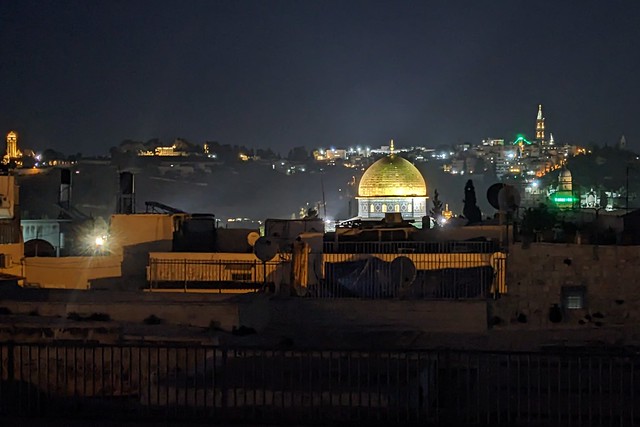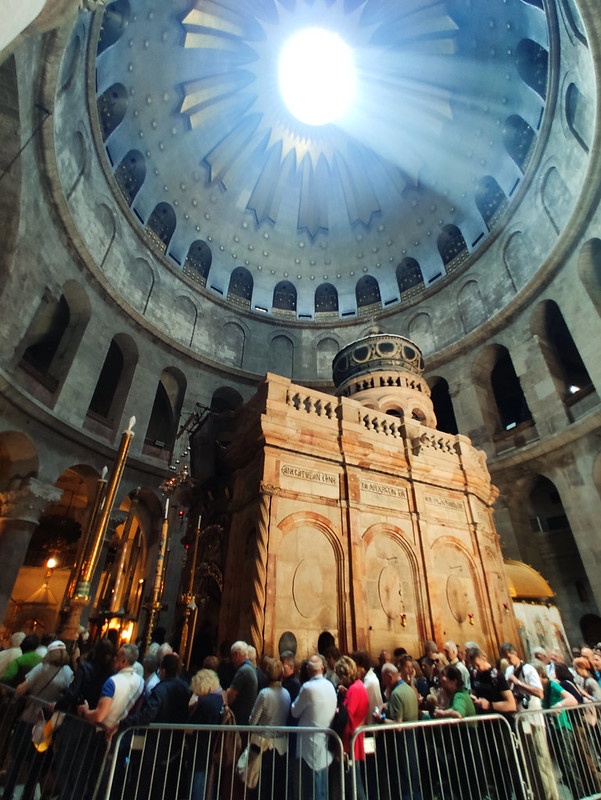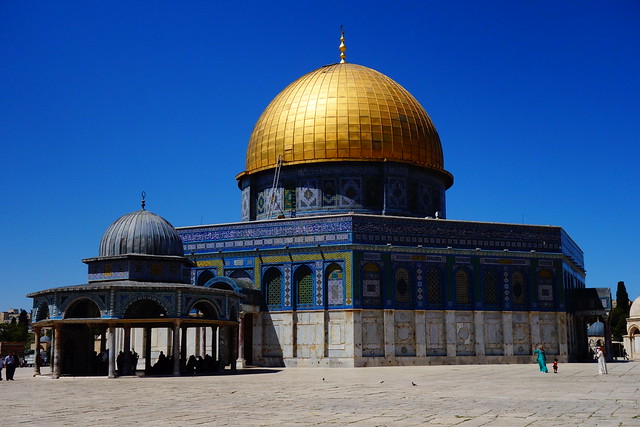


We made our rounds to a few select sites, not unlike when we visited the places of the Budha's birth, first sermon, and death, in Nepal and India.
- The Church of the Holy Sepulchre: supposed site of Jesus' crucifiction and resurrection
This is ground zero for Christians, built, rebuilt, expanded over the centuries. A more apt name would be The Churches of the Holy Sepulchre, because the place consists of different churches/chapels mashed together, and each managed by the 6-7 different sects. We like the mosaics in the Chapel of Calvary. The line for the tomb was insanely long. We had to forgo the experience.



- Western Wall: the west wall of the Second Temple (the first was destroyed by Babylonians in 586 BCE) destroyed by the Romans in 70 CE.
There is lots of security. I had thought I had come into the presence of lots of machine guns in Lebanon. There are more here. The separator (since 1967) for men and women at the wall stood out to me. Were they trying to compete with Muslim neighbors at subjugating women?



- The Dome of the Rock: the supposed spot where Muhammad ascended to heaven, which is also the ex-site of the First and Second Temple for the Jews.
The place is huge. Out of the dozen entrances, only one is allowed for non-Muslims, and is heavily guarded. We were only allowed on the grounds. The mosque looks very beautiful too, but there was no entry for us. (Note to fellow travellers: the place has short, non-contiguous, changeable, visiting hours)



- The Garden of Gethsemane (first below): Jesus was said to have prayed there the night before his crucifixion. With the multitudes of visitors, there is none of tranquility. We were fascinated by the beautiful art nouveau Church of All Nations (2nd below) next to it, and the myriad of hanging lamps at the Tomb of the Virgin Mary (3rd below).



- The Mount of Olives, a frequent haunt of Jesus. There are good views of the old town which attract tour groups.



- Via Dolorosa: the supposed route Jesus took to his crucifixion. This is where the ubiquitous 14 station of the cross supposedly took place. Apparently this has been a pilgrim route for a long time. Much of the route is in the Muslim quarter. The atmosphere is just not there, if not awkward. In our travels, we have seen a number of very moving Via Crucis reenactments during Holy Week/Easter. The beautiful Art Nouveau Church of the Flagellation (below) is the first stop on the Via Dolorosa route.

Religion, brings solace to so many, can be such a source of conflict and discord. By chance we happened to end up in Jerusalem for their Memorial Day and Independence Day. Normally we love gawking at local festivities. Keenly aware of the special situation here, we steered clear of all crowds and gatherings. The irony is that in so many ways Israel is just like their Muslim neighbors
- Hasidic Jewish men scurrying around the city, oblivious to all that surrounds them. John thinks they live in a parallel universe. Many Muslim men go around acting entitled.
- I was surprised to see how many Jewish women cover hair in a wrap, and young women in ankle length skirts.
- Both Hebrew and Arabic are semitic languages, though written in different alphabets.
- If not completely religious states, much of their societies are organized around religion, e.g. state holidays based on religion, Islamic universities and Hebrew universities.
- We were surprised at the number of young Israelis that don't speak English. Education may lead to independent thinking, making it difficult to keep people on Kool-aid.
- Mini-marts have no prices on the shelves. Even supermarkets don't all have all the prices. What's the idea?!
Coming from Egypt and Jordan, we were having sticker shock at the high food cost. Hotel prices are amongst the highest we have encountered which is a reflection of high real estate prices. Both cases are forms of social control. The US is hardly freer. However, in a settler colonial state, it further closes the door on the dispossessed natives.

4 comments:
Beautiful pictures and very interesting comparison between between Judaism and Muslim religions
Hasidic Jews seem to have similar views to fundamentalist Christians and strict Muslims. It is puzzling why all three religions are so restrictive of women. All three originally developed in the Middle East, but that was a long time ago.
@Liz, and they think they are so different, distinguished from one another?!
@Kathy, fundamentalists of any religion/ideology have more in common with each other. I have even accused a friend of being fundamentalist atheist. I don't think these three religions necessarily have the monopoly of oppressing women. Institionalized oppression of women was universal throughout history. What's puzzling is why some men insisting on carrying on the oppression!
Post a Comment